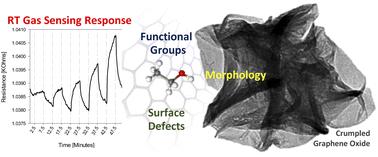当前位置:
X-MOL 学术
›
J. Mater. Chem. A
›
论文详情
Our official English website, www.x-mol.net, welcomes your feedback! (Note: you will need to create a separate account there.)
Crumpled graphene oxide for enhanced room temperature gas sensing: understanding the critical roles of surface morphology and functionalization
Journal of Materials Chemistry A ( IF 11.9 ) Pub Date : 2022-12-01 , DOI: 10.1039/d2ta06883d Kelsey Haddad 1 , Ahmed Abokifa 2 , Siyuan An 1 , Junseok Lee 3 , Baranidharan Raman 4 , Pratim Biswas 1 , John D. Fortner 3
Journal of Materials Chemistry A ( IF 11.9 ) Pub Date : 2022-12-01 , DOI: 10.1039/d2ta06883d Kelsey Haddad 1 , Ahmed Abokifa 2 , Siyuan An 1 , Junseok Lee 3 , Baranidharan Raman 4 , Pratim Biswas 1 , John D. Fortner 3
Affiliation

|
This work fundamentally explores graphene oxide morphology and functionality with regard to room temperature gas sensing performance. Highly-oxidized, crumpled graphene oxide (HO-CGO) was synthesized using a scalable, aerosol-based process. To minimize sample-to-sample synthesis variability, CGO and flat graphene oxide materials were thermally reduced allowing for a serial library of graphene oxide materials with comparable shape and surface chemistries. Room temperature sensitivity to ethanol was then systematically evaluated as a function of curing temperature, time (i.e., degree of thermal reduction), and morphology. HO-CGO showed the strongest response after one hour of reduction at a relatively mild temperature (220 °C), which removed most of the oxygen functionality. In contrast, flat graphene oxide sheets at the same C/O ratios showed no response. Density functional theory (DFT) and ab initio molecular dynamics (AIMD) simulations of ethanol interactions with these material surfaces were employed to develop a mechanistic understanding of the observed enhanced (CGO) sensing response. Adsorption energy calculations revealed that point defects have the most favorable adsorption energy for ethanol, followed by oxygen functionalities, and pristine graphene, respectively. In addition, AIMD on a simulated crumpled structure of graphene oxide indicate that ethanol molecules prefer to adsorb at/in the geometrical valleys of the CGO structure. Enhanced gas sensing performance of CGO is proposed to be a function of structural valleys, which act as both stable sites for oxygen defects and preferential binding sites for the ethanol molecules, whose adsorption occurs through physisorption, with a substantial contribution (∼50%) derived from dispersive forces. This work directly demonstrates the benefits of the crumpled structure of CGO, with concave morphological regions, compared to other carbon-based materials, and informs its processing and material incorporation into functional room temperature gas sensing devices.
中文翻译:

用于增强室温气体传感的皱褶氧化石墨烯:了解表面形态和功能化的关键作用
这项工作从根本上探索了氧化石墨烯形态和功能在室温气体传感性能方面的作用。使用可扩展的、基于气溶胶的工艺合成了高度氧化、起皱的氧化石墨烯 (HO-CGO)。为了最大限度地减少样品之间的合成变异性,对 CGO 和平面氧化石墨烯材料进行了热还原,从而形成了一系列具有可比形状和表面化学性质的氧化石墨烯材料库。然后系统地评估室温对乙醇的敏感性作为固化温度、时间(即,热还原度)和形态。在相对温和的温度 (220 °C) 下还原一小时后,HO-CGO 显示出最强的响应,这消除了大部分氧功能。相比之下,具有相同 C/O 比的扁平氧化石墨烯片没有响应。密度泛函理论 (DFT) 和从头计算乙醇与这些材料表面相互作用的分子动力学 (AIMD) 模拟用于开发对观察到的增强 (CGO) 传感响应的机械理解。吸附能计算表明,点缺陷对乙醇具有最有利的吸附能,其次是氧官能团和原始石墨烯。此外,模拟氧化石墨烯皱折结构的 AIMD 表明乙醇分子更喜欢吸附在 CGO 结构的几何谷处/之中。CGO 增强的气敏性能被认为是结构谷的函数,它既是氧缺陷的稳定位点,也是乙醇分子的优先结合位点,乙醇分子的吸附通过物理吸附发生,分散力的贡献很大(~50%)。这项工作直接展示了与其他碳基材料相比,具有凹形形态区域的 CGO 褶皱结构的优势,并为其加工和材料结合到功能性室温气体传感装置提供了信息。
更新日期:2022-12-01
中文翻译:

用于增强室温气体传感的皱褶氧化石墨烯:了解表面形态和功能化的关键作用
这项工作从根本上探索了氧化石墨烯形态和功能在室温气体传感性能方面的作用。使用可扩展的、基于气溶胶的工艺合成了高度氧化、起皱的氧化石墨烯 (HO-CGO)。为了最大限度地减少样品之间的合成变异性,对 CGO 和平面氧化石墨烯材料进行了热还原,从而形成了一系列具有可比形状和表面化学性质的氧化石墨烯材料库。然后系统地评估室温对乙醇的敏感性作为固化温度、时间(即,热还原度)和形态。在相对温和的温度 (220 °C) 下还原一小时后,HO-CGO 显示出最强的响应,这消除了大部分氧功能。相比之下,具有相同 C/O 比的扁平氧化石墨烯片没有响应。密度泛函理论 (DFT) 和从头计算乙醇与这些材料表面相互作用的分子动力学 (AIMD) 模拟用于开发对观察到的增强 (CGO) 传感响应的机械理解。吸附能计算表明,点缺陷对乙醇具有最有利的吸附能,其次是氧官能团和原始石墨烯。此外,模拟氧化石墨烯皱折结构的 AIMD 表明乙醇分子更喜欢吸附在 CGO 结构的几何谷处/之中。CGO 增强的气敏性能被认为是结构谷的函数,它既是氧缺陷的稳定位点,也是乙醇分子的优先结合位点,乙醇分子的吸附通过物理吸附发生,分散力的贡献很大(~50%)。这项工作直接展示了与其他碳基材料相比,具有凹形形态区域的 CGO 褶皱结构的优势,并为其加工和材料结合到功能性室温气体传感装置提供了信息。


























 京公网安备 11010802027423号
京公网安备 11010802027423号